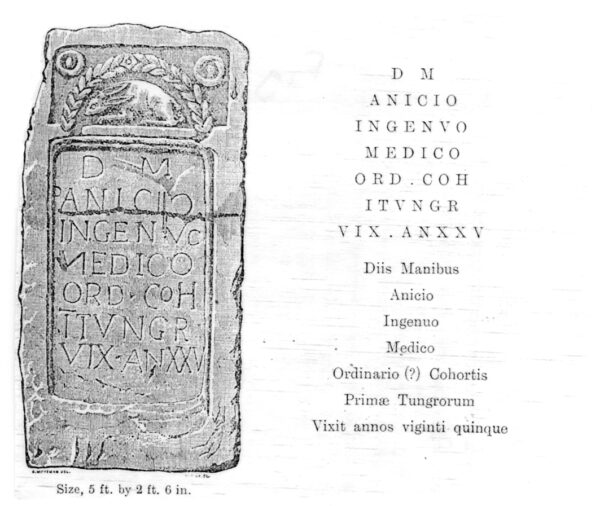
The Roman Army Medical Service assisted Roman soldiers using a wide variety of medical techniques and specialist equipment, some of which was used for very specific purposes.
Roman soldiers would have suffered from many of the same illnesses as we do today. But some of the injuries they received as they battled across Northern Britain were quite distinct from those encountered in modern warfare.
Slashing and cutting wounds from swords would have been particularly common. Occasionally these could be quite deep, exposing internal organs – in fact, military service was seen as a golden opportunity for physicians to learn more about human anatomy!
Other weapons used by the British tribes included spears, knives, axes, stone sling shot and, less commonly, arrows. Consequences for some unfortunate Roman soldiers included fractures, head and eye injuries in addition to penetrating abdominal and chest wounds.
All cuts and abrasions needed cleaning and dressing: some others required stitching too. Sometimes, more complicated surgery was necessary to remove bone fragments, stop bleeding or to extract spear points.
Traumatic wounds are at particular risk of getting infected and honey dressings were frequently used by the Romans. The military physician Dioscorides wrote that `honey is cleansing, opens pores, and draws out fluids. Boiled and applied it heals flesh that stands separated` . Nowadays we are beginning to appreciate the wisdom of our ancient forbears and the important healing properties of natural honey.
A lot of basic wound care would have been provided by fellow soldiers, some of whom – the capsarii – were trained first aiders. On Trajan`s column a capsarius is shown bandaging a fellow soldier’s leg and two others are assisting a wounded comrade (Figure 1). The capsarii were probably under the control of a doctor with the rank of a centurion, the medicus ordinarius. The richly embellished tombstone of Anicius Ingenuus, medicus ordinarius of the first cohort of Tungrians from Housesteads perhaps reflects his importance amongst his colleagues (Figure 2).

The repair of a simple flesh wound was the most performed surgical procedure undertaken by individuals such as Anicius Ingenuus. Basic surgical kits consisting of probes, hooks, forceps, needles, cautery tools and scalpels were readily available (Figure 3), and several possible items have been discovered in excavations at Malton.

Stitching cuts with a needle and thread was not dissimilar to the approach used today, but if there were any concerns about infection or inflammation the fibulae technique was often preferred. This entailed passing copper-alloy skewers through the wound and then looping threads around them in a figure-of-eight fashion. The Roman author Celsus wrote that `fibulae leave the wound wider open…..in order that there may be an outlet for any humour collecting within` (Figure 4).

Some surgical instruments available to Roman military surgeons were quite ingenious. The Dioclean cyathiscus was a spoon-shaped tool with a small hole at the base to take the point of a spear or arrowhead. It would have been passed down into the wound and then rotated slightly to accommodate the weapon which could then have been withdrawn. Specially made forceps would have been used to remove bone fragments as well as for clipping arteries and stopping bleeding (Figure 5).

In a fort such as Malton it is highly likely that there was a military hospital – valetudinarium – as was the case at many of the forts along Hadrian’s Wall. At Housesteads a possible hospital has been identified behind the principia away from the general hustle and bustle of the fort. It is rectangular in plan with a series of small rooms arranged around a central courtyard (Figure 6).

Unlike our modern hospitals valetudinaria were quite small, being only able to accommodate up to 5% of a unit. Soldiers requiring long-term care or convalescence might have been granted sick leave to recuperate elsewhere. From Malton some may even have travelled to the Bridlington area benefitting from the healing effects of sea water and sea air, perhaps at Gabrantwikone Bay mentioned by the 2nd Century geographer Ptolemy.
Figure 1: Capsarius illustrated on Trajan`s Column ©Creative Commons Attribution-Share Alike 4.0 International
Find out more about Trajan’s Column on Wikipedia
Figure 2: Tombstone of Ancinus Ingenuus, medicus ordinarius, from Housesteads ©Nick Summerton
Figure 3: Reconstructed basic medical kit: forceps, needles (bone & brass), scalpels, probes and skin hooks ©Nick Summerton
Figure 4: The use of fibulae for skin closure ©JF Ratcliffe
Figure 5: A pair of forceps for removing bone fragments or clipping arteries (reproduction) ©Nick Summerton
Figure 6: The hospital at Housesteads ©Nick Summerton
Found out more about Housesteads from English Heritage

[…] depicted on Trajan’s Column. From “The Roman Army Medical Service,” Malton Museum. CC BY-SA […]